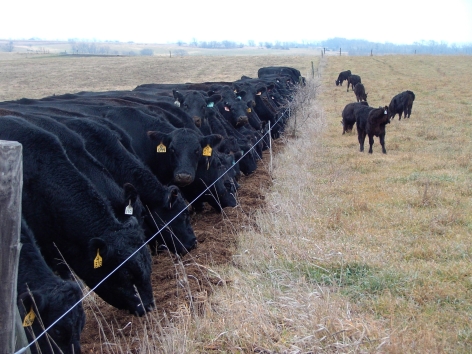
ISU researchers are collecting nasal mucus samples from cattle to gain insight into the bacteria populations that live in the animals' respiratory systems. Larger image.
AMES, Iowa – Bacteria often get a bad rap. Frequently the targets of aggressive hand-washing campaigns, they get the blame for causing a wide range of nasty diseases in humans and animals.
But animal science researchers at Iowa State University are examining some of the helpful purposes bacteria can serve in the respiratory and digestive systems of beef cattle.
A pilot program at Iowa State recently began collecting nasal mucus and fecal matter samples from cattle on the ISU McNay Research and Demonstration farm in Chariton. The researchers will study those samples to gain a better understanding of the interaction between the bacteria populations and the cattle.
James Reecy, director of the ISU Office of Biotechnology and a professor of animal science who is leading the project, said bacteria often share a mutually beneficial relationship with the organisms they live on or in.
“They’re present every day,” Reecy said. “But there’s some sort of symbiotic relationship for a lot of the bacteria. We probably survive because they’re here. The aim of this project is to get a better understanding of that interaction and find ways we can use it to our benefit with cattle.”
For instance, he said bacteria can help an animal metabolize nutrients in food that the organism may not be able to digest on its own. That’s what happens when ruminant animals like cows store food in the first compartment of their stomachs. After bacteria help break down the food, the animal then regurgitates the partially digested matter and ingests it a second time, a process known as ‘chewing the cud.’
And none of it would be possible without the helpful bacteria in the ruminant animal’s stomach.
Reecy said most of the samples will come from cattle as they enter the feedlot. He said that’s the greatest time of susceptibility to disease, and those samples will yield the best look at how bacteria populations make cattle more or less vulnerable to illnesses.
After the samples are taken, researchers will sequence the bacterial DNA that’s present to find out how prevalent the bacteria are. Then the researchers will try to make connections between the bacteria and certain traits expressed by the cattle.
Reecy said the ultimate goal is to discover how the bacteria interact with the genetics of the cattle. Finding a balance between the right bacteria and the right genetics could lead to breakthroughs in beef production.
And for anyone who might think healthy bacteria are only for production animals, Reecy said humans and bacteria have the same kinds of relationships.
“There are lots of them on our bodies and in our bodies every day, and there’s nothing wrong with that,” he said. “In many cases they’re probably beneficial.”